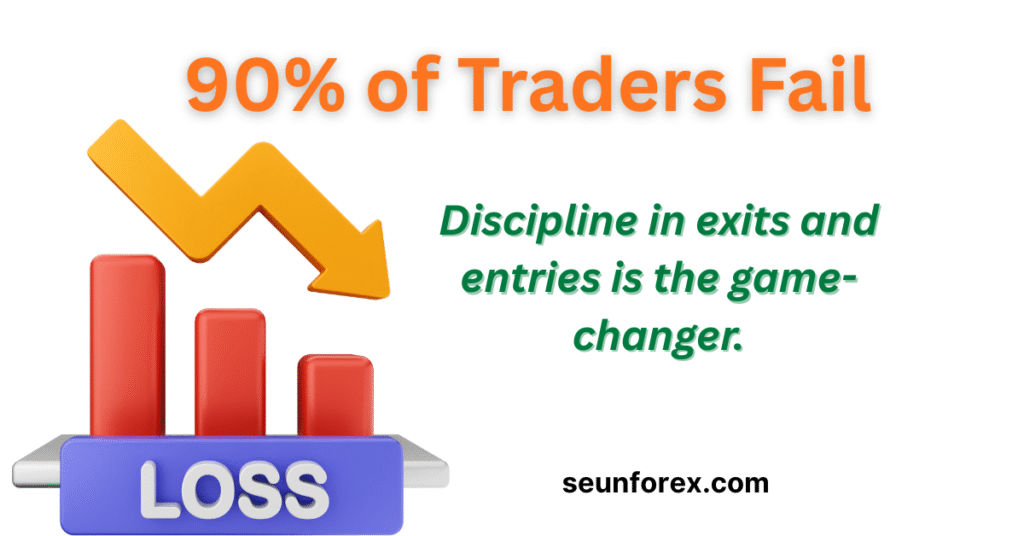
If most traders would learn to sit on their hands 50 percent of the time, they would make a lot more money.”
— Bill Lipschutz
When traders fail, it is rarely because the market was unfair or unpredictable. Most losses occur because there is no map, no guardrail, no plan. Building patience in trading begins with having a clear roadmap. Trading without a plan is like driving on a highway blindfolded—you may cover some distance, but you’re likely to crash.
Discipline is the bridge between knowledge and results—it is what separates those who lose habitually from those who win consistently. The discipline to follow a trading plan is not optional. Without it, even the most advanced trading psychology strategies will fail.
This guide explores why patience in forex trading matters, how to build discipline step by step, and how to control emotions in trading so you don’t abandon your rules when the market tests you.
🧭 The Foundation: What is a Trading Plan?
A trading plan is more than a set of rules. It is the blueprint of your trading life. It defines:
- Entry criteria: When and why you’ll take a trade.
- Exit criteria: How you’ll lock in profits or cut losses.
- Risk management: How much capital you’re willing to risk per trade, per day, and per week.
- Psychology management: How you respond to losses, streaks, and emotional triggers.
- Review and adaptation: How you measure results and evolve over time.
A trading plan provides structure and clarity. Without it, you are reactive, guided by fear, greed, and the illusion of control.
Think of your trading plan as a GPS for financial markets. Without it, every detour is a potential disaster.
🧪 Why Traders Fail Without a Plan
Statistics sStatistics show that over 90% of traders lose money within the first year, and a large portion of these failures is due to a lack of disciplined planning. One of the overlooked solutions is building patience in trading, because without patience, even a well-designed system will collapse.
Here’s why:
- Impulse Over Strategy
Markets are engineered to provoke emotions. Headlines, sudden spikes, or rumors trigger impulsive trades. A trader without a plan will enter positions on gut feelings, chasing “hot moves” without understanding the mechanics. Practicing building patience in trading ensures that trades are filtered through strategy instead of emotion.
Example: A trader buys a currency pair because of a sudden tweet about central bank policy. The trade spikes, then crashes, resulting in a 4% account loss. If this trade had been evaluated against a pre-defined plan, it would have been skipped.
- Poor Risk Management
Without rules, risk multiplies. Traders overleverage, ignore stop-loss rules, or commit too much capital to one trade.
Example: A swing trader risks 10% of the account on one trade, violating standard risk protocols. One failed trade wipes out months of gains.
- Lack of Consistency
Jumping between strategies without a structured evaluation leads to inconsistent results.
Strategy hopping example: Day trading one week, scalping the next, then switching to long-term forex positions—none are tracked systematically.
- Emotional Interference
Revenge trading, fear of missing out (FOMO), and greed override logic. Traders who ignore the plan often double down to recover losses or chase profits, compounding mistakes.
Case: After losing two trades, a trader attempts to make back all losses in a single position. The trade fails, increasing the loss from 2% to 7%.
- No Accountability or Review
Many traders fail because they do not track results, mistakes, or emotional states. Without a journal or review system, errors repeat endlessly.
The irony: traders spend years learning strategies but fail to learn themselves, which is the most critical aspect of success.
The irony: traders spend years learning strategies but fail to learn themselves, which is the most critical aspect of success.
🧮 Building Your Trading Plan, Step by Step

Let’s break down a practical, actionable trading plan for modern traders.
1. Define Your Market Universe
Decide which assets, instruments, and timeframes you will trade.
- Forex: EUR/USD, GBP/USD, USD/JPY
- Indices: S&P 500, Nasdaq 100, Dow Jones
- Commodities: Gold, Oil, Silver
- Cryptocurrencies: BTC, ETH, XRP
The narrower your focus, the easier it is to master patterns, risk, and correlations. Traders who scatter attention across dozens of instruments rarely succeed because the mental bandwidth required to manage all of them exceeds capacity.
Pro tip: Focus on 1–3 markets at a time. Master them before expanding.
2. Set Entry Rules
Be precise about what conditions must be met before taking a trade. Avoid vague ideas like “buy when it feels right.”
Examples of structured entry rules:
- Technical trigger: Price breaks above 20-day moving average, confirming a trend.
- Volume confirmation: Trade only if volume exceeds average daily volume, indicating participation.
- Macro alignment (optional): Economic indicators or news events that support your trade.
- Example: “Enter EUR/USD long only when daily candle closes above EMA20, volume exceeds 10-day average, and no high-impact news is scheduled within 2 hours.”
Why this works: It removes emotion, guesswork, and reactionary decisions.
3. Set Exit Rules
One of the most overlooked aspects of trading plan discipline is having precise and consistent exit rules. Too many traders obsess over entry signals but neglect exits, where profits or losses are actually realized.
Define both profit targets and stop-loss levels before entering a trade:
- Stop-loss discipline: Limit risk to 1–2% of account equity per trade. This keeps your capital safe and reflects sound risk management.
- Profit targets: Aim for at least 2–3x the initial risk, ensuring a minimum risk-to-reward ratio of 1:2. This aligns with professional forex discipline, where protecting downside is as important as capturing upside.
💡 Psychological trick: By setting your exit rules in advance, you reduce emotional conflict. The market may tempt you to “hold a little longer” or “close too early,” but sticking to predefined trading rules prevents impulsive decisions and strengthens your trading psychology.
Example: If you risk $200 on a trade, your profit target should be at least $400. If the market hits your stop-loss, you exit automatically—no questions, no hesitation, no second-guessing.
📌 Remember: Exits matter as much as entries. Without disciplined exit rules, even the best strategy can fail. This is why trading plan discipline must always include a detailed exit framework—because consistency beats cleverness in the long run.s much as entries. Most traders lose because they hold too long or cut winners too early.
4. Risk Management Discipline
Risk rules are non-negotiable. Even the best setups fail without proper risk control.
Core rules:
- Max daily loss = 3–4% of total capital
- Max weekly loss = 7–8% of total capital
- Reduce position size after consecutive losses
- Never increase risk impulsively to “recover” losses
Discipline here is survival. Without it, you won’t have an account to trade tomorrow.
5. Emotional Management
Psychology can make or break your trading plan.
- Keep a trading journal to track emotional state before, during, and after trades.
- Use pause or breathing techniques during streaks of wins or losses.
- Accept losses as part of the process—this prevents revenge trading.
Discipline is emotional armor. It protects you from your own impulses.
6. Review and Adapt
A trading plan is not static. Treat it as a living document:
- Weekly review: Evaluate win/loss ratios, drawdowns, and adherence to rules.
- Adjust rules only after data shows consistent patterns, not on impulse.
- Identify behavioral weaknesses: Are you overtrading? Ignoring stops?
A plan without review is like a GPS without updates: eventually, it leads you off course.
🧩 The Psychology of Discipline

Discipline is more than “following rules.” It is the foundation of a strong trading plan discipline—thinking long-term when the market tempts you with short-term wins.
Impulse vs. Process: The brain craves instant gratification. Trading psychology demands you replace impulse with structured, methodical action.
Pain of Loss vs. Reward of Patience: Every professional knows that patience in trading means tolerating small, manageable losses to avoid catastrophic blowups.
Consistency beats Cleverness: Even a mediocre strategy executed with trading consistency outperforms brilliant strategies applied recklessly. This is why risk management in trading is non-negotiable—it turns survival into long-term success.
Discipline is not boring; it is freedom. Freedom from emotional chaos and reactionary trading.
📊 Common Pitfalls and How to Avoid Them
| Pitfall | Solution |
|---|---|
| Chasing hot trades | Pre-plan entries and ignore market noise |
| Revenge trading | Step back after a loss; never increase risk impulsively |
| Ignoring risk rules | Automate stop losses and max exposure |
| Strategy hopping | Stick to 1–2 proven setups, refine them over time |
| Overtrading | Set max trades per day; quality over quantity |
Heed these consistently, and your plan becomes a powerful shield against common trading mistakes.
🗺️ Case Studies of Plan Discipline in Action
1. The 2020 COVID Crash
Traders with strict risk rules survived:
- Reduced positions when volatility spiked
- Avoided emotional trades despite panic headlines
- Maintained journaled discipline → faster recovery
2. 2018 Quantitative Tightening
Traders without plans:
- Increased risk due to overconfidence
- Ignored systematic exits
- Suffered large drawdowns unnecessarily
3. 2022–2023 Market Consolidations
Disciplined traders:
- Respected stop-losses during sideways moves
- Avoided trend-chasing in low-momentum periods
- Used small positions to test market sentiment before scaling
Lesson: Discipline turns chaos into opportunity.
🛠️ Practical Workflow for Trading Plan Discipline
- Morning Prep
- Check news and macro events
- Review previous day’s performance
- Note psychological state
- Before Entering Trades
- Confirm setup meets plan criteria
- Check risk:reward ratios
- Apply position sizing rules
- During Trade
- Stick to the plan
- Avoid emotional interference
- Note observations in journal
- After Trade
- Record outcome, reasoning, feelings
- Adjust notes, not positions impulsively
- Celebrate discipline wins, not just profits
Process is your engine; emotion is the derailleur to avoid.
✅ Heuristics for Consistent Discipline
- Plan first, trade second
- Loss is temporary, ruin is permanent
- Trade with numbers, not narratives
- Pullbacks are friends, not enemies
- Volume confirms conviction
- Emotion is the enemy; process is the ally
Keep these heuristics visible on your trading screen. They are mental triggers to enforce discipline.
🧠 Psychology with a Wink to Legendary Traders
Mark Minervini: Patience and structured growth are non-negotiable.
Paul Tudor Jones: Risk management over ego; capital preservation first.
Ed Seykota: Consistency and emotional control outperform cleverness.
All legends agree: trading plan discipline is the backbone of trading success. In fact, as Investopedia explains in 10 Steps to Building a Winning Trading Plan, a structured plan protects traders from emotional decisions and improves long-term performance.
Patience is also a hidden edge. I’ve covered this more deeply in Patience in Trading: The Hidden Edge for Consistent Gains, where I show why waiting for the right setups often separates amateurs from professionals. Without patience and trading plan discipline, even the most skilled strategies can fall apart.
All legends agree: discipline is the backbone of trading success.
📌 Checklist: Apply Tomorrow
- ✅ Define your market universe
- ✅ Set precise entry and exit rules
- ✅ Set stop-loss, profit targets, max risk
- ✅ Record all trades in journal
- ✅ Review previous day, adjust plan only after analysis
- ✅ Check emotional readiness before trading
- ✅ Confirm trades meet plan criteria
🎀 The Bow on Top
Discipline in trading is not glamorous; it doesn’t make headlines. But it is the silent engine that turns small gains into sustained success.
When you follow your plan:
- You stop guessing.
- You stop panicking.
- You trade like a professional.
Without discipline, even the best strategies fail. With discipline, even a simple plan outperforms brilliant ideas executed inconsistently.
Build your plan. Respect it. Trade it. Repeat. That is how ordinary traders become extraordinary.